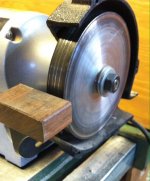SAG 180
Titanium
- Joined
- Sep 17, 2007
- Location
- Cairns, Qld, Australia
First a disclaimer: I'm just getting into scraping so take anything I post here with a couple of grains of salt.
These are some photos of a jury rigged setup for sharpening carbide scrapers and brazed lathe tools that I made. What I would really appreciate is some suggestions on how to improve the current setup into a more permanent form. I have a plated 100 grit 4" cup wheel on the far left, then a 1200 grit charged cast iron flywheel off a DC motor for an exercise treadmill, then another iron flywheel with 3000 grit and finally a 4" 240 grit resin cup wheel on the far left. It all runs off a DC treadmill motor with PWM speed control and small ATX drive belt with surprisingly good balance at all speeds.
So far it's worked well for rough shaping and fine polishing a 20mm square carbide insert brazed to a 16 inch flat steel bar. I can see the 100 grit plated cup wheel could do with water feed as I've nearly killed it grinding some glass at low speed dry: optometry labs have a wet bench grinder setup with a trough at the bottom of the wheels with a recess for a wet sponge in contact with the grinder wheel to keep it damp and wipe the glass paste off the grinding surface.
There's already been a few cross contamination issues with the oil/diamond paste picking up the odd particle from the rougher grits so you get a few scratches when polishing that disappear with use. I'll probably replace the 100 grit cup with a 6" plated faceting lap in 120 grit and keep the resin 240 grit for now. I'd appreciate some suggestions and ideas/photos of what everyone else uses to sharpen their scrapers before making my jury rig more permanent.



These are some photos of a jury rigged setup for sharpening carbide scrapers and brazed lathe tools that I made. What I would really appreciate is some suggestions on how to improve the current setup into a more permanent form. I have a plated 100 grit 4" cup wheel on the far left, then a 1200 grit charged cast iron flywheel off a DC motor for an exercise treadmill, then another iron flywheel with 3000 grit and finally a 4" 240 grit resin cup wheel on the far left. It all runs off a DC treadmill motor with PWM speed control and small ATX drive belt with surprisingly good balance at all speeds.
So far it's worked well for rough shaping and fine polishing a 20mm square carbide insert brazed to a 16 inch flat steel bar. I can see the 100 grit plated cup wheel could do with water feed as I've nearly killed it grinding some glass at low speed dry: optometry labs have a wet bench grinder setup with a trough at the bottom of the wheels with a recess for a wet sponge in contact with the grinder wheel to keep it damp and wipe the glass paste off the grinding surface.
There's already been a few cross contamination issues with the oil/diamond paste picking up the odd particle from the rougher grits so you get a few scratches when polishing that disappear with use. I'll probably replace the 100 grit cup with a 6" plated faceting lap in 120 grit and keep the resin 240 grit for now. I'd appreciate some suggestions and ideas/photos of what everyone else uses to sharpen their scrapers before making my jury rig more permanent.


 Anyway, the point is it will prevent any potential edge chipping/breakout.
Anyway, the point is it will prevent any potential edge chipping/breakout. .
.
